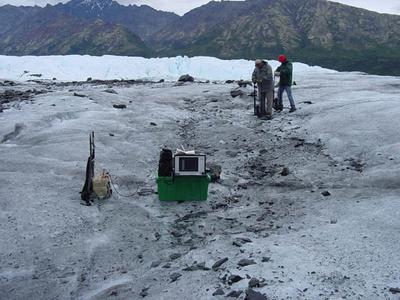29 July, 2002
On the ice......
The weather broke enough today to allow me to collect some GPR data. Darren
Bake, and Tim Alessi, two REU students helped me pack the gear up the
glacier and then collect data. We were lucky enough to catch a window
between showers that provided enough time to gather the data. It was
considerably warmer today than yesterday, at least when the wind wasnıt
blowing. However, It was still very cloudy with no hint of clearing up.
Itıs much more difficult to predict what the weather will be like here than
at home. There is no nightly weather report to plan the following day by.
As mentioned in my journal yesterday, we collected data along four separate
profile lines laid out 90o to the flow of the glacier and spaced at 10m
intervals up glacier from the hole. I wasnıt able to tell whether I got
good results as the data will need to be processed before a clear image will
be able to be seen.
We also moved the gear further up ice to a second hole that will be used.
For this data set, the hole was left empty. This will serve as comparison
for data collected with weights in the hole. Once this data was collected,
we set the weights down the hole, one at the bottom (139m), one at 80m and a
third at 40m. The weights are supported by line and tied of to a pole that
spans the opening of the hole. This rigging will hole the weights in place
until they freeze in to the ice. We then ran radar over the same profile
line as before. Once again, as this data was collected no clear images were
seen, however, processing should clear it up.
Iıve attached a couple pictures. One of them shows the process of
collecting GPR data on the ice. The other is another processed radar image
collected last week.
Life Is Good,
DT

Darren Bake (in the lead) and Tim Alessi (behind) collect GPR data. They are holding the radar antennae. The data is being gathered by the computer on the green box. The system is powered by a car battery, which can be seen attached to the frame pack.

This is a radar image processed from data collected as a weight was being pulled up a hole. There is a scale for depth in the right hand margin. The scale across the top indicates the number of traces, or the number of received radar impulses. The top of the grey area near the center of the image represents a reflection off of the weight as it was being raised.
Contact the TEA in the field at
.
If you cannot connect through your browser, copy the
TEA's e-mail address in the "To:" line of
your favorite e-mail package.
|
